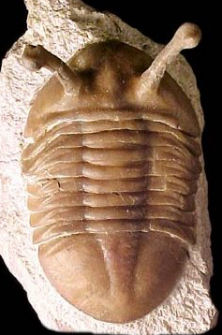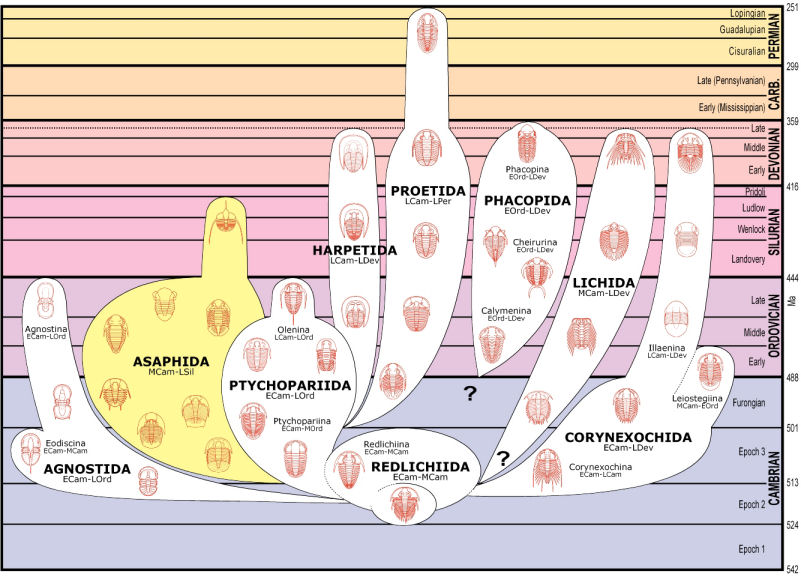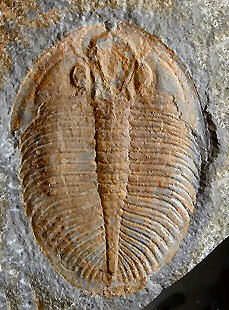Click on images
for pictorial guides: Isotelus
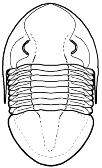 asaphoid protaspis
Isotelus
 | ORDER ASAPHIDA
(sensu Fortey & Chatterton 1988, Fortey 1990)
last revised 08 July 2020 by S. M. Gon III
Diagnostic features shown in this color
Introduction: A large (comprising perhaps 20% of trilobite species) and morphologically diverse order of trilobites, most advanced families united by similar ontogeny (the ovoid, effaced "asaphoid" protaspid form with enrolled doublure); most members also have a median ventral suture (only secondarily lost via fusion in two advanced families).
Cephalon: often equal/subequal to pygidium (e.g., Asaphoidea), but some not so (e.g., Trinucleioidea); usually with a high degree of cephalic effacement so glabellar furrows are faint or not visible; eyes usually large (some forms secondarily blind); preoccipital glabellar tubercle in advanced forms; cephalic doublure often wide, with terrace ridges; librigena are typically separated by a median ventral suture; dorsal anterior facial sutures often curve adaxially to meet in front of the glabella; sutures opisthoparian; hypostome conterminent or impendent, with only primitive forms (e.g., the Anomocaroidea) natant.
Thorax: typically 5 – 12 segments, but 2 - 3 in a few Trinucleioidea, 13+ in some Anomocaroidea, up to 30 in an Alsataspidid (Trinucleioidea).
Pygidium: typically large (subisopygous to macropygous), with a wide doublure.
Occurrence: Middle-Upper Cambrian boundary to upper Ordovician-lower Silurian.
Suborders: None (or nominate Asaphina).
Superfamilies: Anomocaroidea, Asaphoidea, Dikelocephaloidea, Remopleuridoidea, Cyclopygoidea, Trinucleioidea. |
Click on images
for pictorial guides: Anomocaroidea
Pterocephalidae
Housia
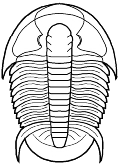
.
.
Anomocarellidae
Glyphaspis
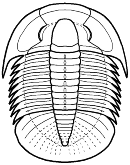
| Superfamily Anomocaroidea Introduction: Primitive Asaphida (possibly ancestral to some other asaphine groups), including families retaining the natant hypostomal condition, as well as other ptychoparioid features; protaspides resembling those of Ptychopariida (not "asaphoid"); not all families included may be monophyletic (i.e., Anomocaroidea as described here is likely a paraphyletic group).
Cephalon: preglabellar field wide; glabella typically parallel or gently tapering, with 3 or 4 pairs of furrows more or less of ptychoparioid type, palpebral lobes long, sickle-shaped; natant hypostome, median ventral suture; natant hypostome, some approaching conterminant.
Thorax: 10-13+ segments.
Pygidium: typically large, with broad, usually concave border, 2-10 axial rings.
Families: Andrarinidae, Anomocarellidae, Anomocaridae, Aphelaspididae, Parabolinoididae, Pterocephalidae (including Housiidae).
Genera: Andrarinidae: Andrarina (/Liostracus), Groenwallia, Groenwallina.
Anomocarellidae: Anomocarella (=Psilaspis; = Entorachis), Eoanomocarella, Fissanomocarella, Glyphaspis (=Americare), Hanshania, Huayuania, Liocare, Liopeishania, Liopelta, Luia, Lydiaspis, Megalopsis, Neoanomocarella, Orthodorsum, Paranomocarella, Peishania, (=Parapeishania), Peishanoides, Plebiellus.
Anomocaridae: Abharella, Afghanocare, Amginia, Anomocare, Anomocarina, Anomocarioides, Anomocariopsis, Callaspis, Chondranomocare, Dilatalimbus, Elandaspis, Eocatuniella, Forchammeria, Formosocephalus, Fuquania, Glyphanellus, Glyphaspellus, Guizhouanomocare, Hanivella, Harataspis, Hunanaspis, Igarkiella, lohomia, Irinia, Jimanomocare, Juraspis, Kokuria, Kolbinella, Kotuia, Leichneyella, Lomsucaspis, Longxumenia, Macrotoxus, Metanomocare, Nadiyella, Palella, Paracoosia (=Manchurocephalus), Parakotuia, Paranomocare, Pjatkovaspellus, Qinlingia, Rectifrontinella, Sachaspis, Schoriecare, Schoriella, Scintilla, Sivovella, Usovinurus, Wutingshania, Yongwolia.
Aphelaspididae: Amorphella, Aphelaspidella, Aphelaspis (=Proaulacopleura; =Clevelandella; =Labiostria), Apheloides, Dicanthopyge, Elegantaspis, Erixanium, Eugonocare, Kobayashella, Listroa, Litocephalus, Maduiya, Nganasanella (=Tamaranella), Notoaphelaspis, Olenaspella, Olentella, Paraphelaspis, Pseudaphelaspis, Pseudeugonocare, Taenicephalites, Taenora.
Parabolinoididae: Abdulinaspis, Apornodocia, Boestrupia, Croixana, Jasmundia, Kendallina (/Kendallia), Minkella, Orygmaspis, Parabolinoides (=Bernia), Pedinocephalus, Pesaiella, Roksaspis, Stigmacephaloides, Taenicephalops, Taemcephalus (=Bemaspis; =Maustonia), Weishania.
Pterocephaliidae: ?Anecocephalus, Beigongia, Bromella, Camaraspis, Cernuolimbus, Cilia, Dikelocephalioides, Dikelocephalites, Dingxiangaspis, Flabellocephalus, Guangxiaspis, Housia (=Housiella), Jubileia, Labiostrella, Labiostrina (=Abia), Longlingaspis, Lunacephalus, Luotuolingia, Morosa, Parahousia, Paramaladioidella, Pauciella, Pedinaspis, Pedinocephalites, Pelicephalus, Petalocephalus, Plesiocilia, Prehousia, Proapatokephaloides, Prodikelocephalites, Pterocephalia (/Pterocephalus; =Hederacauda), Pterocephalina, Pterocephalopsinus (/Pterocephalops LIN & ZHANG in ZHU et al., 1979), Pulchricapitus (=Reaganaspis), Qilianaspis, Sigmocheilus, Stenambon, Strigambitus, Tiantouzhania, Tumicephalus, Uxunella, Xiaoshiella, Yingziaspis, Yokusenia, Yushugouia, Zhenania, Zhuangliella. |
Click on images
for pictorial guides: Asaphoidea
Asaphidae
Asaphus
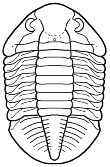 .
Asaphidae
Ptyocephalus
 .
Ceratopygidae
Ceratopyge
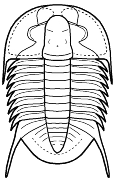
| Superfamily Asaphoidea Introduction: As in typical Asaphida with the following additional defining characteristics:
Cephalon: bearing preoccipital glabellar tubercle; glabella elongate, subparallel to tapering forward, with defined occipital ring, curved, apostrophe-like pair of basal glabellar furrows isolated within glabella; hypostome conterminant (rarely impendent)
Thorax: typically 8 segments (6 to 9 in some Ceratopygidae)
Pygidium: typically rounded and without spines, but sometimes with a terminal spine or pair of spines (e.g., Thysanopyginae).
Families: Asaphidae, Ceratopygidae.
Genera: Asaphidae: Anataphrus, Araiocaris, Asaphellus (=Asaphelloides; =Asaphoon; =Hemigyraspis; =Megalaspidella; =Plesiomegalaspis), Asaphus (=Schizophorus), Atopasaphus, Aulacoparia, Aulacoparina, Australopyge, Baltiites, Banqiaoites, Basilicus (=Basiliella; =Carinobasiliella; =Dolerobasilicus/ Basilicoides; =Mekynophrys; =Parabasilicus), Bellefontia, Birmanitella, Birmanites (=Opsimasaphus), Bohemopyge (/Ptychocheilus), Borogothus, Brachyaspis, Branisaspis, Burminresia, Charabaia, Chengkouella, Dubovikites, Ectenaspis, Ekeraspis, Emanuelaspis, Emanuelina, Eoasaphus (/Anorina), Eoisotelus, Erdelia (/Maja), Estoniites, Fuyunia, Gerasaphes, Gog, Gogiura, Golasaphus, Griphasaphus, Guohongjunia, Hazarania, Heraspis, Hoekaspis, Homalopyge, Hunjiangites, Hunnebergia, Huochengia, Iduia, Isabelinia, Isotella, Isoteloides, Isotelus (=Homotelus), Isyrakella, Isyrakopeltis, Kainisiliellina, Kayseraspis, Klabavia, Kobayashia, Lachnostoma, Lamanskytes, Lapidaria, Leningradites, Liomegalaspides, Lisogorites (=Trigonoaspis; =Tangyaia), Liushuicephalus, Lonchobasilicus (=Sinomegalaspis), Lycophron, Megalaspidella, Megalaspides (=Lannacus), Megasaphus, Megatemnoura, Megistaspidella (=Spinopyge), Megistaspis (/Megalaspis; =Megistaspinus; =Rhinaspis), Merlinia, Metaptychopyge, Metayuepingia, Mioptychopyge, Mischynogorites, Nahannia, Neoasaphus (=Trematophoris; =Multiasaphus; =Postasaphus; =Subasaphus), Neopeltis, Nerudaspis, Nileoides, Ningkianites, Niobe, Niobella (=Metoptogyrus), Niobides, Niobina, Nobiliasaphus (=Pamirotchechites), Norasaphites, Norasaphus, Norinia, Notopeltis, Ogmasaphus, Ogyginus, Ogygiocarella, Ogygiocaris, Ogygitella, Ogygites, Ogygitoides, Onchometopus, Parabellefontia, Paramegalaspis (=Dolerasaphus), Paramegistaspis (/Varvaspis), Paraptychopyge, Paratamdaspis, Parayuepingia, Penchiopsis, Platyptychopyge, Plectasaphus, Plesiyuepingia, Popovkiaspis, Popovkites, Praecoparia, Presbynileus (/Paranileus), Priceaspis (=Fitzroyaspis), Proasaphus, Promegalaspides, Protopresbynileus (/Pseudonileus HINTZE, 1953), Protoptychopyge, Proxiniobe, Pseudoasaphinus, Pseudoasaphoides, Pseudoasaphus, Pseudobasilicoides, Pseudobasilicus, Pseudobasiliella, Pseudobasiloides, Pseudogriphasaphus, Pseudogygites, Pseudomegalaspis, Pseudoptychopyge, Pseudoptyocephalus, Psilocephalina, Psilocephalops, Ptychopyge, Ptyocephalus (=Kirkella), Rhinoferus (=Lawiaspis; =Ropschiaspis), Sanbernardaspis, Shergoldina, Stegnopsis, Stenorhachis, Suriaspis, Tchukeraspis, Thysanopyge (=Basilicoides), Trigonocerca, Trigonocercella, Tsaidamaspis, Valdaites, Vogdesia, Volchovites, Xenasaphus, Xenostegium, Xinanocephalus, , Yuepingioides, Zhenganites (=Eosoptychopyge), Zoraspis, Zuninaspis.
Ceratopygidae: ?Ajacicrepida, Asiocephalus, Boschchekulia, Cataplotaspis, Ceratopyge, Cermatops, Charchaqia (=Aplotaspis), Diceratopyge (=Paraceratopyge), Dichelepyge (=Bicornipyge), Dipleuropyge, Guozia, Haniwoides (=Yuepingia), Hedinaspis, Hunanopyge, Hysterolenus (=Ruapyge/ Hectoria), Kaltykelina, Kaufmannella (/Kaufmannia), Kogenium, Lopnorites, Macropyge (=Haniwapyge, =Lichapyge; =Macropygella), Mansuyella, Nannopeltis, Neohedinaspis, Onychopyge (=Prionopyge), Proceratopyge, Promacropyge (=Aksapyge), Pseudohysterolenus, Pseudoyuepingia (=Iwayaspis; =Sayramaspis), Sinoproceratopyge, Tamdaspis (=Psiloyuepingia), Tropidopyge, Wannania, Xiaodaositunia. |
| Click
on images for pictorial guides:
Trinucleioidea
Raphiophoridae
Ampyx
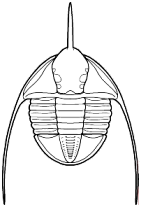
Trinucleidae
Cryptolithus
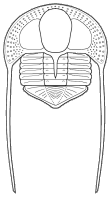 | Superfamily Trinucleioidea (moved to Order Trinucleida in 2019)
Cephalon: Opisthoparian or marginal facial sutures, generally eyeless; glabella typically convex and pyriform, with 3 or fewer pairs of furrows, preoccipital glabellar tubercle sometimes present; usually long genal spines.
Thorax: usually 5 – 8 segments, but only 2-3 segments in progenetic Raphiophoridae, and up to 30 in Seleneceme (Alsataspididae), with long, narrow adaxial pleurae.
Pygidium: wide, typically triangular, narrow axis extending to posterior margin, border strongly declined, doublure very narrow.
Other: Globular protaspis was considered a unifying character arguing for inclusion in Order Asaphida, but is now considered independantly derived; Raphiophorus is the only Trinucleioid (indeed the only representative of the order Asaphida) that continues beyond the Ordovician-Silurian boundary.
Families: Alsataspididae (including Orometopidae), Dionididae, Liostracinidae, Raphiophoridae, Trinucleidae,
Genera: Alsataspididae: Ajrikina, Alataupleura, Araiopleura, Calycinoidia, Caputrotundum, Clavatellus, Falanaspis, Hapalopleura, Huamiaocephalus, Jegorovaia (=Hermosella), Jiangxiaspis, Orometopus, Pagometopus, Palquiella, Paracalymenemene (/Paracalymene LIU), Plesioparabolina, Pyrimetopus, Rhadinopleura, Seleneceme (=Alsataspis), Sibiriopleura, Skljarella (=Proaraiopleura), Spirantyx, Trigocephalus, Yumenaspis, Zacompsus.
Dionididae: Aethedionide, Digrypos, Dionide (/Dione; /Polytomurus; =Dionidepyga; =Trigrypos), Dionideina, Dionidella, Huangnigangia, Paradionide, Tongxinaspis, Trinucleoides.
Liostracinidae: Aplexura, Doremataspis, Liostracina, Lynaspis.
Raphiophoridae: Ampyx (/Brachyampyx), Ampyxella, Ampyxina, Ampyxinella, Ampyxoides, Anisonotella, Bulbaspis, Caganaspis, Carinocranium, Cerampyx, Cnemidopyge, Collis, Edmundsonia, Ellsaspis, Endymionia (/Endymion), Globampyx, Jiuxiella (=Miboshania), Kanlingia, Lonchodomas, Malinaspis, Malongullia (=Ampyxinops), Mendolaspis, Metalonchodomas, Miaopopsis, Nambeetella, Nanshanaspis, Parabulbaspis, Parampyx, Pseudampyxina, Pytine, Raphioampyx, Raphiophorus, Raymondella (/Reedaspis), Rhombampyx, Salteria, Sinampyxina, Sinoluia, Taklamakania (=Xinjiangia).
Trinucleidae: Anebolithus, Australomyttonia, Bancroftolithus, Bergamia (=Bohemaspis; =Brandysops; =Cochliorrhoe), Bettonolithus, Botrioides, Broeggerolithus (=Ulricholithus), Costonia, Cryptolithoides, Cryptolithus, Deanaspis, Declivolithus, Decordinaspis, Eirelithus, Famatinolithus, Furcalithus, Guandacolithus, Gymnostomix, Hanchungolithus (=Ichangolithus; =Yinjiangolithus), Huenickenolithus, Incaia, Jianxilithus, Lloydolithus, Lordshillia, Marekolithus, Marrolithoides, Marrolithus, ?Microdiscus, Myinda, Myindella, Myttonia, Nankinolithus, Ningkianolithus (=Cerato1ithus; =Hexianolithus), Novaspis, Onnia, Paratretaspis, Paratrinucleus, Parkesolithus, Pragolithus, Protoincaia, Protolloydolithus, Reedolithus, Reuscholithus, Salterolithus (=Smeathenia), Stapeleyelta, Telaeomarrolithus, Tetrapsetlium, Tretaspis, Trinucleus (/Edgellia), Whittardolithus, Xiushuilithus, Yinpanolithus. |
| Click on images for pictorial guides: Dikelocephaloidea
Dikelocephalidae
Dikelocephalus
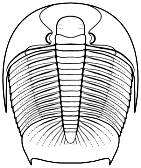 | Superfamily Dikelocephaloidea Cephalon: with opisthoparian sutures, glabella typically truncate anteriorly and squat, 1-4 pairs of lateral furrows, 1p may be transglabellar; preglabellar field variable, sometimes absent, palpebral ridge typically well-defined, but separate from axial furrow (compare to sister group Remopleuroidea); genal spines typically present, of various length; median ventral suture rarely lost to secondary fusion; hypostome conterminant
Thorax: 8-12 segments, axis convex, pleurae typically wider than length of axis, typically with short, pointed ends (longer in Loganellidae).
Pygidium: micropygous to isopygous, variable shape, axis often extends majority of length, sometimes with post-axial ridge, posterior margin smooth or spined (1-5 pairs of marginal spines)
Families: Dikelocephalidae, Eurekiidae, Ptychaspididae, Saukiidae, Loganellidae.
Genera: Dikelocephalidae: Berkeia, Blandicephalus, Briscoia, Camaraspoides, Dikelocephalus, Elkia, Goumenzia, Hoytaspis, Iranella, Kasachstanaspis, Monocheilus, Olimus, Osceolia, Parabriscoia, Patalolaspis, Princetonella (/Calyptomma), Pterocephalops RASETTI, Randicephalus, Stigmacephalus, Walcottaspis.
Eurekiidae: Bandalaspis, Bayfieldia, Corbinia, Eurekia, Leocephalus, Lochmanaspis, Magnacephalus, Maladia, Tostonia.
Ptychaspididae: Alborsella, Changia (=Coreanocephalus; =Quadraticephalus; =Fengshania), Eoptychaspis, Eowuhuia, Euptychaspis, Idiomesus, Kathleenella, Keithia, Keithiella, Macronoda (=Promesus), Plectrella, Proricephalus, Ptychaspis (=Asioptychaspis), Saukioides (/Pseudosaukia; /Jeholaspis), Sunwaptia, Wilcoxaspis.
Saukiidae: Anderssonella (/Anderssonia, /Sunina), Calvinella, Caznaia, Danzhaisaukia, Diemanosaukia, Eosaukia (=Scolosaukia), Galerosaukia, Guangnania, Hamashania, Lichengia, Linguisaukia, Liquania, Lophoholcus, Lophosaukia, Mareda, Metacalvinella, Mictosaukia, Mictosaukioidia, Paracalvinella, Pileaspis, Platysaukia, Prosaukia (=Stenosaukia), Pseudocalvinella, Saukia, Saukiella, Sinosaukia, Stigmaspis, Tellerina, Thailandium, Wedekindiaspis (/Wedekindia).
|
| Click
on images for pictorial guides: Cyclopygoidea
Cyclopygidae
Cyclopyge
 .
Nileidae
Nileus

| Superfamily Cyclopygoidea Cephalon: with glabella expanding forward to anterior margin, effaced in later cyclopygids, may be fused with occipital ring; fixigenae reduced (except in primitive Taihungshaniidae), palpebral lobes lack distinct rims, and contact axial furrows at anterior ends, librigenae fused or separated by anterior median suture; hypostome relatively transverse, impendent, often with tripartite posterior margin; eye various sized (may be hypertrophied and convex (Cyclopyge), typically closely adjoined to glabella.
Thorax: 5-8(9?) segments.
Pygidium: medium to large (subisopygous in Nileidae), axis usually with 2-5 rings (but up to 20+ in advanced Taihungshaniidae), may be smooth, or with indistinct furrows.
Families: Cyclopygidae, Nileidae, Taishunghaniidae
Genera: Cyclopygidae: Amicus, Aspidaeglina, Circulocrania, Cyclopyge (/Egle/Aeglina), Degamella, Ellipsotaphrus, Emmrichops, Gastropolus (=Lisogoraspis), Girvanopyge (=Cremastoglottos; =Gamops; =Nanlingia), Heterocyclopyge (=Selenoptychus), Microparia (=Gallagnostoides), Novakella (=Incisopyge), Paramicroparia, Phylacops, Pricyclopyge (=Bicyclopyge), Prospectatrix, Psilacella, Quadratapyge, Sagavia, Symphysops, Waldminia, Xenocyclopyge.
Nileidae: Aocaspis, Barrandia, Berkutaspis, Borthaspidella, Bumastides, Elongatanileus, Homalopteon, Illaenopsis (=Eurymetopus; =Procephalops; =Rokycania/Pseudobarrandia), Kodymaspis, ?Lakaspis, Neopsilocephalina, Nileus (=Remopleuridioides), Parabarrandia, Parabumastides, Paranileus, ?Peraspis, Petrbokia, Platypeltoides (/Platypeltis), Poronileus, Psilocephalinella (/Psilocephalus/ Psilocephalina/Borthaspis), Shenjiawania, Symphyroxochus, ?Symphysurina (=Symphysurinella; =Symphysuroides), Symphysurus, Troedssonia, Varvia.
Taihungshaniidae: Asaphellina, Asaphopsis, Omeipsis, Pacootella, Renhuaia, Taihungshania (=Miquelina), Tungtzuella. |
| Click
on images for pictorial guides: Remopleuridoidea
Remopleurididae
Remopleurides
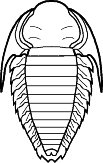
.
.
Remopleurididae
Robergia
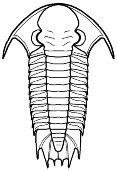 | Superfamily Remopleuridoidea Cephalon: with opisthoparian sutures, glabella bulges tranversely anterior of occipital ring, with up to 3 pairs lateral furrows, eyes medium to very large, with narrow, wire-like socle, palpebral rims inflated, deep rim furrows, extending into axial furrows anteriorly; genal spines present.
Thorax: 9-12 segments, axis convex, pleural furrows diagonal, pleural tips typically point backward.
Pygidium: with spinose margin, spines flattened, united at bases, extending to axis; convex axis not extending to posterior margin, pleural field flat, typically furrowed and backward curving. Surface variously sculptured or granulose.
Families: Auritamiidae, Bohemillidae, Hungaiidae (including Dikelokephalinidae), Idahoiidae (including Loganellidae), Remopleurididae (including Kainellidae).
Genera: Auritamidae: Auritama, Metopotropis.
Bohemillidae: Bohemilla, Fenniops.
Hungaiidae: Asaphopsoides (=Dainellicauda; =Xiangxiia), Ciliocephalus, Dactylocephalus, Dikella, Dikelocephalopsis, Dikelokephalina, Dikelus, Hungaia (=Acrohybus), Hungioides (=Argentinops), Leimitzia, Meitanopsis, Songtaoia, Warendia, Xiushanopsis.
Idahoiidae: Aguilarella, Arrhenaspis, Brabbia, Comanchia, Duibianaspis, Elviraspis, Langyashania, Lauzonella, Leviscila, Loganellus (=Highgatea), Maladioidella (=Kuruktagella; =Cedarellus), Noelaspis, Patronaspis, Psalaspis, Pyttstrigis, Saratogia (=Idahoia, =Meeria), Shitaia, Valtoressia, Wafangia, Wilbernia, Zhuitunia.
Remopleurididae: Aktugaiella, Amphitryon (/Caphyra; =Brachypleura), Aotiaspis, Apatokephalina, Apatokephaloides, Apatokephalops (=Aristokainella; =Wanliangtingia), Apatokephalus, Apiflabellum, Arator, Artokephalus, Atratebia, Auricula, Binervus, Blosyropsis, Cavia, Deanokephalus, Diplapatokephalus, Dislobosaspis, Eoapatokephalus, Eorobergia, Haniwa, Hastiremopleurides, Hexacopyge, Hualongella, Hukasawaia, Hypodicranotus, Ivshinaspis, Jiia, Jingheella, Jinshaella, Kainella, Kainellina, Kainelloides, Lacorsalina, Lingukainella, Lohanpopsis, Loshanella, Lulongia, Makbelaspis, Mendosina, Menoparia, Naustia, Oculeus, Poletaevia, Portentosus, Praepatokephalus, Proapatokephalops, Pseudokainella (=Elkanaspis; =Parakainella; =Fatocephalus), Pugilator, Remopleurella, Remopleurides, Remopleuridiella, Richardsonaspis, Richardsonella (=Lakella; =Protapatokephalus), Robergia, Robergiella, Scinocephalus, Sculptaspis, Sculptella, Sigmakainella, Spinacephalus, Taishania, Teratorhynchus, Tibikephalus, Tramoria, Yosimuraspis (=Eoyosimuraspis; =Metayosimuraspis). |
| ADDITIONAL CLASSIFICATION NOTES FOR ASAPHIDA:
Fortey & Chatterton (1988) provided an extensive summary of evidence uniting the clades within the suborder Asaphina, and later, arguments were presented by Fortey (1990) for the recognition of an emmended Order Asaphida, as described here. The assumption is that the ventral median suture evolved only one time, thereby uniting all members bearing that feature as a monophyletic group. As a stem group composed of primitive asaphid families (such as Anomocaridae), the Anomocarioidea is paraphyletic, giving rise to the derived superfamilies, and presumably including the most primitive transitional taxa for each (such as some Auritamiidae).
The ontogeny of the advanced members of the Asaphida (e.g., Asaphoidea, Trinucleioidea, Cyclopygoidea) are consistent, with an effaced, globular protaspis. However, the hypothesis that the globular protaspis evolved only once was challenged by Bignon et al (2019) who split out the Trinucleioidea from Asaphida and re-erected the order Trinucleida, which is here accepted.
Whittington (2003) argued that at least some of the Nileidae (e.g., Lakaspis, Peraspis, and Symphysurina; see Cyclopygoidea above) should not be placed in that family, and that most nileids should be considered Illaenina (Corynexochida). If so, then the argument of the ventral median suture as a central synapomorphy for the Asaphida requires reconsideration. Expanded and complete genera listings for the families above are from Jell & Adrain (2003).
.
To view a chart of relationships within the Asaphida, click here.
Bignon, A., B. G. Waisfeld, N. E. Vaccari, & B.D.E. Chatterton. 2019. Reassessment of the Order Trinucleida (Trilobita). J. Syst. Paleontol. 18(13): 1061-77.
Fortey, R. A. 1990. Ontogeny, hypostome attachment, and trilobite classification. J. of Paleontology. 33:529-76.
Fortey, R. A. 2001. Trilobite systematics: the last 75 years. J. of Paleontology. 75(6):1141-51.
Fortey, R. A. and B. D. E. Chatterton. 1988. Classification of the Trilobite Suborder Asaphina. Palaeontology 31(1):165-222
Jell, P.A. & J.M. Adrain. 2003. Available generic names for trilobites. Memoirs of the Queensland Museum 48(2):331-553.
Whittington, H.B. 2003. The trilobite family Nileidae: Morphology and Classification. Palaeontology 46(4):635-46. |
